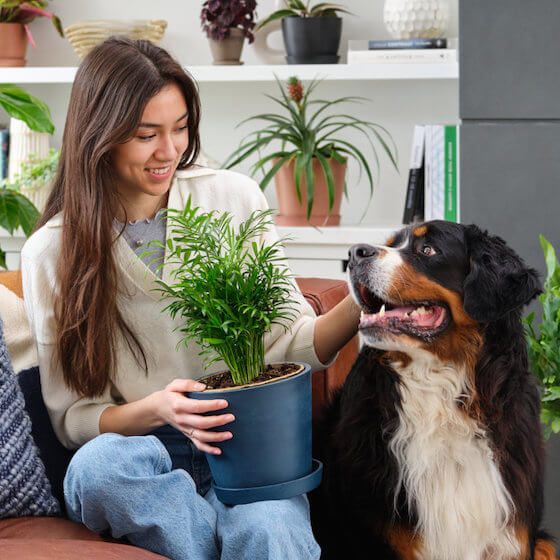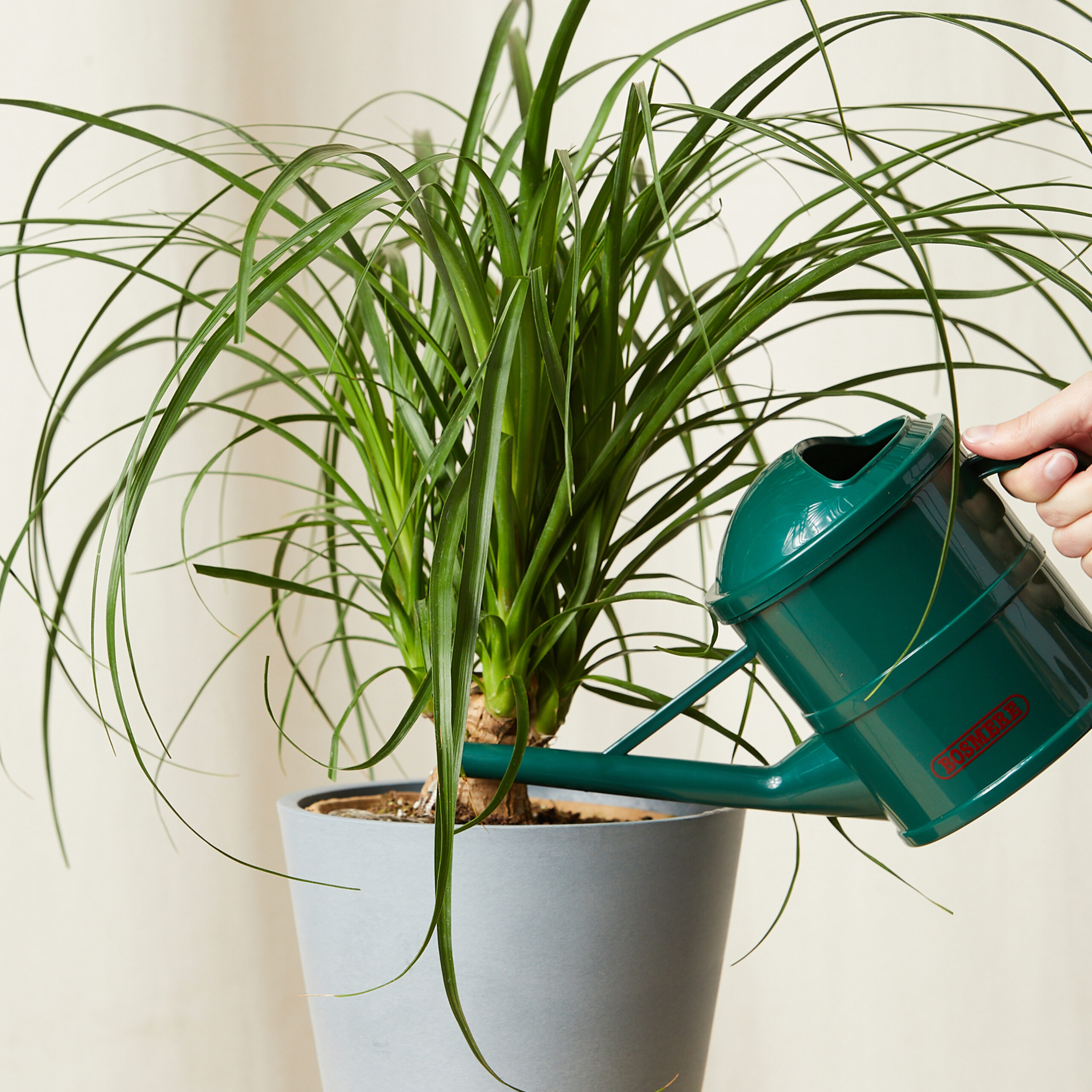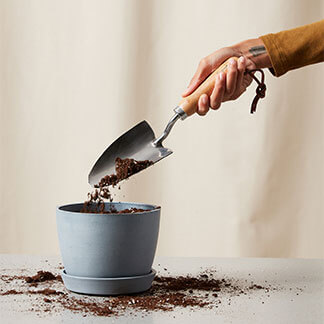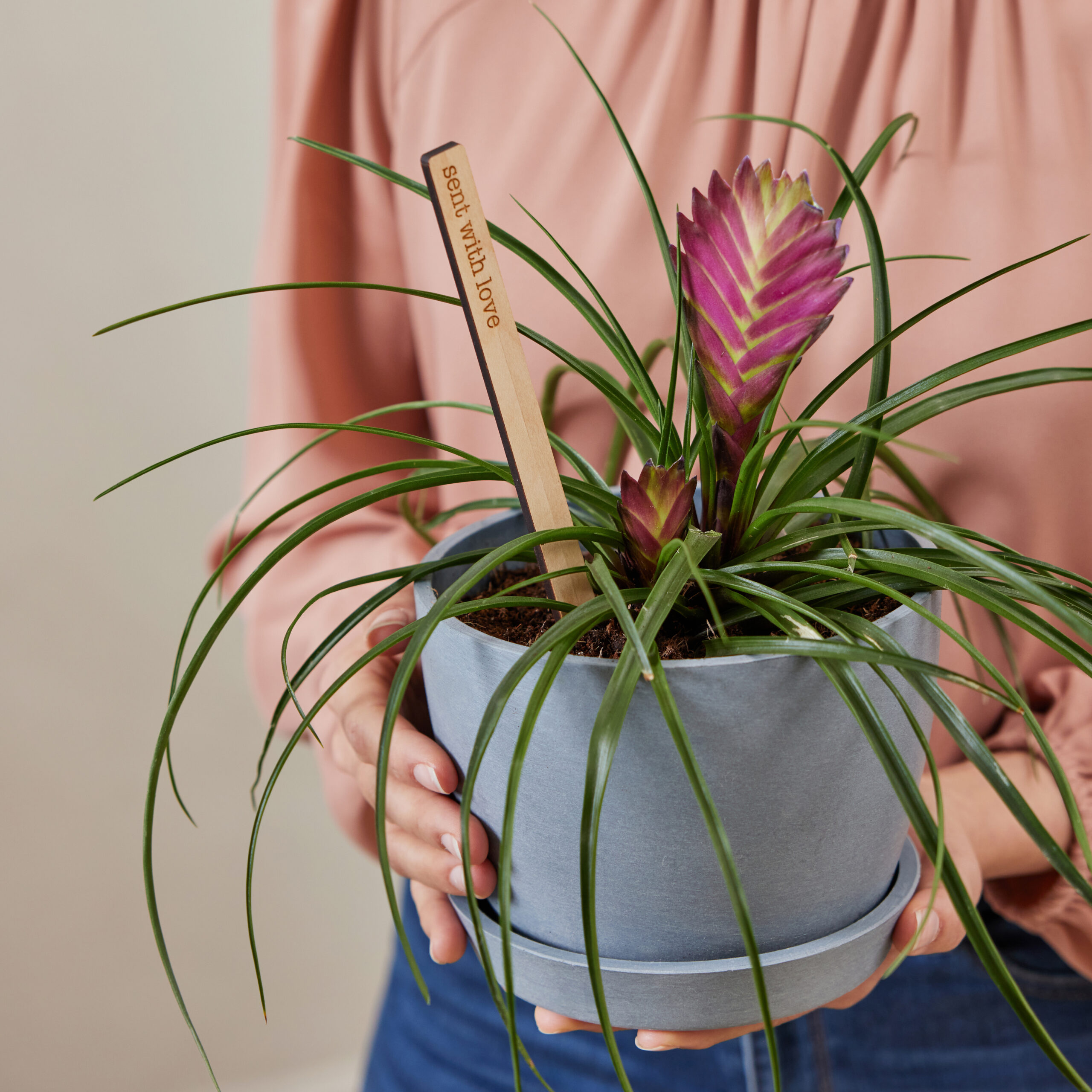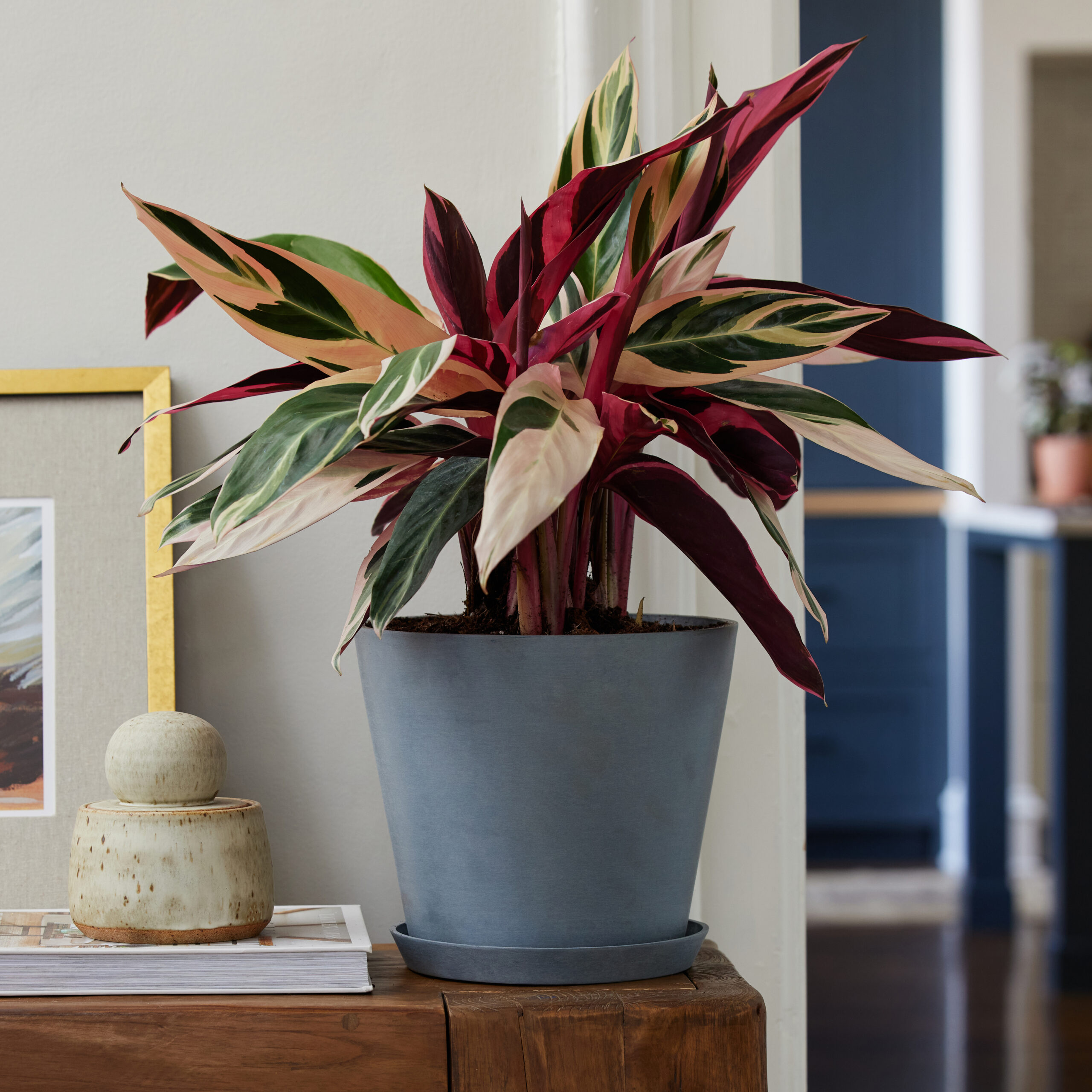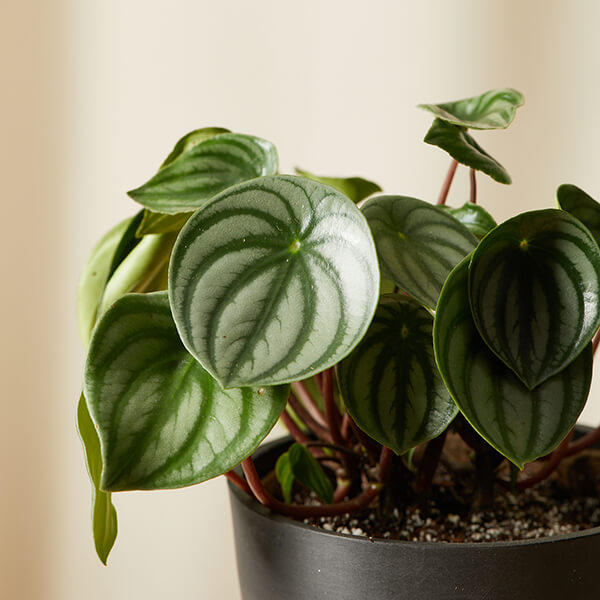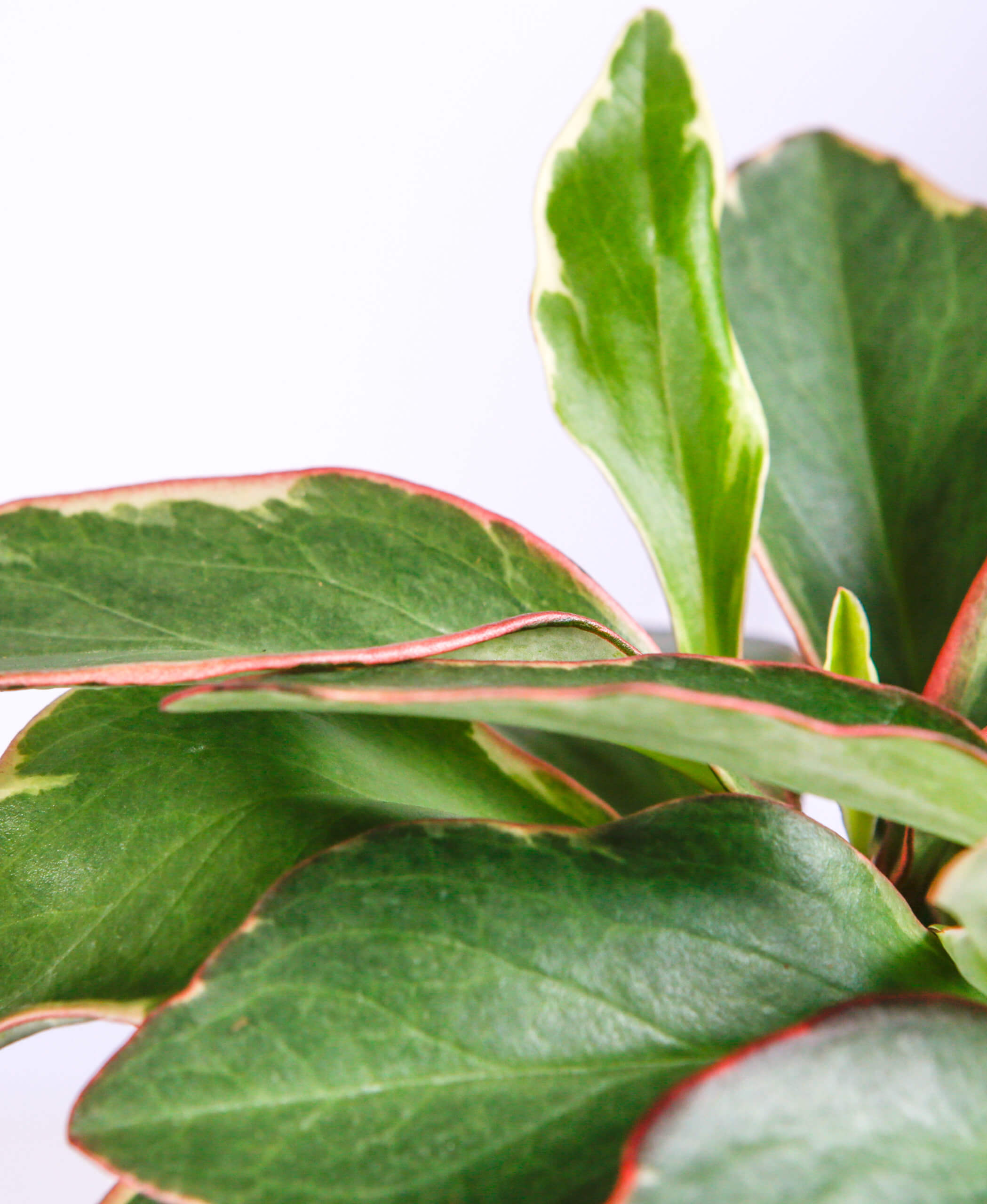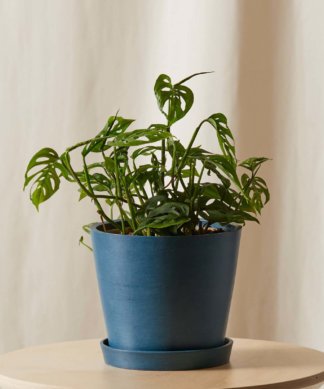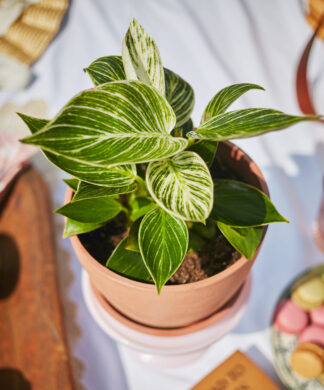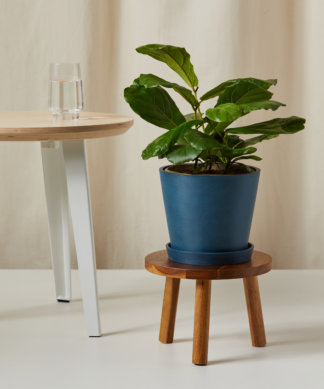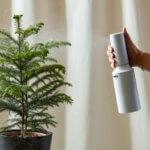How to care for your Peperomia
Use these instructions to care for a Peperomia. This guide will tell you how to water a Peperomia; its light, temperature, humidity preferences and any additional care it might need to help it grow.
Peperomia Cupid
Place your Peperomias in low to indirect light. Too little light can cause slow growth while too much light can burn the foliage.
Water your Peperomia when 50%-75% of the soil volume is dry. Water until liquid flows through the drainage hole at the bottom of the pot and discard any water that has accumulated in the saucer.
Peperomias will tolerate average household humidity. However, like most tropical plants, they will benefit from added humidity. You can add humidity by placing a humidifier nearby, misting often, or using a pebble tray.
Peperomias prefers average room temperatures between 65-75°F.
Your Peperomia will benefit from regular fertilizing during the growing season. Feed once per month in the spring and summer months with general houseplant fertilizer diluted to half the recommended strength.
Peperomias are non-toxic to humans and pets.
Trailing peperomias can be easily propagated. If you want to multiply your plants or share with a friend, make a cut on a vine below a leaf node, and stick the stem into the water. The plant should respond by sending new shoots from the cut node. Roots will begin to develop after a few weeks. Once roots develop, transfer to soil and keep moist.
Peperomia Frost
Your Peperomia Frost prefers bright, indirect light. It can tolerate lower light conditions, but growth may slow.
Water your Peperomia Frost when the top 50-75% of the soil is dry. Water thoroughly, until excess water flows from the drainage hole into the saucer, but do not allow your Peperomia to sit in excess water or soggy soil. Your Peperomia Frost is similar to a succulent in that it stores water in its leaves and can tolerate drying out a bit between waterings.
Your Peperomia Frost will tolerate average household humidity. However, like most tropical plants, it will benefit from added humidity. You can add humidity by placing a humidifier nearby, misting often, or using a pebble tray.
Your Peperomia Frost prefers average room temperatures between 60-80 degrees.
Your Peperomia Frost will benefit from regular fertilizing during the growing season. Feed once per month in the spring and summer months with general houseplant fertilizer diluted to half the recommended strength.
Your Peperomia Frost is non-toxic and pet-friendly!
Peperomia can be easily propagated through leaf cuttings. If you want to multiply your plants or share with a friend, make a cut on a stem below a leaf, and stick the stem into the water. Roots will begin to develop after a few weeks. Once roots develop, transfer to soil and keep moist.
Peperomia Ginny
Place your peperomia in low to indirect light. Too little light can cause slow growth while too much light can burn the foliage.
Water your peperomia when 50%-75% of the soil volume is dry. Water until liquid flows through the drainage hole at the bottom of the pot and discard any water that has accumulated in the saucer.
Your peperomia does well in average household humidity. However, if the air is very dry it will appreciate the occasional humidity boost.
Peperomias prefers average room temperatures between 65-75°F.
Your peperomia will benefit from regular fertilizing during the growing season. Feed once per month in the spring and summer months with general houseplant fertilizer diluted to half the recommended strength.
The Peperomia Ginny is non-toxic to pets and humans if ingested.
Peperomia can be easily propagated through stem cuttings. To propagate, cut a stem below a leaf node and stick the stem into fresh, clean water or soil. The cutting will develop roots after a few weeks. Once roots develop, transfer to soil and keep moist until established.
Peperomia Green
Your Peperomia prefers bright indirect light. It can adapt to medium and low light, but growth may slow. Keep out of direct sunlight, which can burn the leaves.
Water your Peperomia when 50%-75% of the soil volume is dry. Water until liquid flows through the drainage hole at the bottom of the pot and discard any water that has accumulated in the saucer. The semi-succulent leaves and stems mean this plant is very forgiving of a missed watering.
Your Peperomia does not require extra humidity to thrive.
Your Peperomia prefers temperatures between 60-80°F. It does not tolerate temperatures below 50°F, so keep it away from drafty areas during the winter.
Feed your Peperomia once during the spring and once during the summer with a general-purpose houseplant fertilizer diluted to half strength. No fertilizer is needed during the winter months when growth naturally slows.
Your Peperomia is non-toxic to pets and humans.
Peperomia can be easily propagated through stem cuttings. To propagate, cut a stem below a leaf and stick the stem into the water. Roots will develop after a few weeks. Once roots develop, transfer to soil and keep moist.
Peperomia Happy Bean
Your Peperomia prefers bright indirect light. It can adapt to medium and low light, but growth may slow. Keep out of direct sunlight, which can burn the leaves.
Water your Peperomia when 50%-75% of the soil volume is dry. Water until liquid flows through the drainage hole at the bottom of the pot and discard any water that has accumulated in the saucer. The semi-succulent leaves and stems mean this plant is very forgiving of a missed watering.
Your Peperomia does not require extra humidity to thrive.
Your Peperomia prefers temperatures between 60-80°F. It does not tolerate temperatures below 50°F, so keep it away from drafty areas during the winter.
Feed your Peperomia once during the spring and once during the summer with a general-purpose houseplant fertilizer diluted to half strength. No fertilizer is needed during the winter months when growth naturally slows.
Your Peperomia is non-toxic to pets and humans.
Peperomia can be easily propagated through stem cuttings. To propagate, cut a stem below a leaf and stick the stem into the water. Roots will develop after a few weeks. Once roots develop, transfer to soil and keep moist.
Peperomia Hope
Place your Peperomias in low to indirect light. Too little light can cause slow growth while too much light can burn the foliage.
Water your Peperomia when 50%-75% of the soil volume is dry. Water until liquid flows through the drainage hole at the bottom of the pot and discard any water that has accumulated in the saucer.
Peperomias will tolerate average household humidity. However, like most tropical plants, they will benefit from added humidity. You can add humidity by placing a humidifier nearby, misting often, or using a pebble tray.
Peperomias prefers average room temperatures between 65-75°F.
Your Peperomia will benefit from regular fertilizing during the growing season. Feed once per month in the spring and summer months with general houseplant fertilizer diluted to half the recommended strength.
Peperomias are non-toxic to humans and pets.
Trailing peperomias can be easily propagated. If you want to multiply your plants or share with a friend, make a cut on a vine below a leaf node, and stick the stem into the water. The plant should respond by sending new shoots from the cut node. Roots will begin to develop after a few weeks. Once roots develop, transfer to soil and keep moist.
Peperomia Obtusifolia Variegated
Your Peperomia will be happiest in medium to bright indirect light, however, they can tolerate lower light and can even adapt to fluorescent lighting. Keep out of direct sun—the leaves will burn.
Water your Peperomia when the top 50%-75% of the soil is dry. Water until liquid flows through the drainage hole at the bottom of the pot and discard any water that has accumulated in the saucer. This small houseplant can effectively hold water in their fleshy stems and leaves during times of drought, making it quite forgiving if you forget to water it once in a while.
Your Peperomia will enjoy a misting from time to time.
Your Peperomia prefers temperatures between 55–80 degrees during the day and should not get colder than 55 degrees at night.
Feed once during the spring and once during summer with a liquid fertilizer for indoor plants.
Your Peperomia is non-toxic to pets and humans.
If your Peperomia becomes unkept or out of hand, trim the leaves using sharp, clean pruning shears or scissors.
Peperomia Piper
Place your Peperomia in low to indirect light. Too little light can cause slow growth while too much light can burn the foliage.
Water your Peperomia when 50%-75% of the soil volume is dry. Water until liquid flows through the drainage hole at the bottom of the pot and discard any water that has accumulated in the saucer.
Your Peperomia does well in average household humidity. However, if the air is very dry it will appreciate the occasional misting.
Peperomias prefers average room temperatures between 65-75°F.
Your Peperomia will benefit from regular fertilizing during the growing season. Feed once per month in the spring and summer months with general houseplant fertilizer diluted to half the recommended strength.
The Peperomia Piper is non-toxic to pets and humans.
If your Peperomia Piper becomes unkept or out of hand, feel free to trim the leaves using sharp, clean pruning shears or scissors. Peperomia can be easily propagated through leaf cuttings. To propagate, cut a stem below a leaf and stick the stem into the water. Roots will develop after a few weeks. Once roots develop, transfer to soil and keep moist.
Peperomia Pixie Lime
Place your Peperomia Pixie Lime in bright indirect light. It can tolerate direct sun in the morning or late afternoon, but avoid the harsh midday sun which can scorch the foliage. Peperomias can tolerate low light, but growth will slow considerably.
Water your Peperomia when 75% of the soil volume is dry. Water until liquid flows through the drainage hole at the bottom of the pot and discard any water that has accumulated in the saucer.
Your Peperomia does well in average household humidity. However, if the air is very dry it will appreciate the occasional humidity boost.
Peperomia prefers indoor temperatures between 65-80°F.
Feed monthly in the spring through fall with a general-purpose indoor plant fertilizer diluted to half strength. Before applying fertilizer in any form, make sure the soil is damp. No fertilizer is needed in the winter when growth naturally slows.
This plant is considered non-toxic to humans and pets.
Peperomia can be easily propagated through stem cuttings. To propagate, cut a stem with a few leaves just above a leaf node. Remove the lowest 1-2 leaves and stick the stem into fresh, clean water or moist soil. The cutting will develop roots after a few weeks. Once roots develop, transfer to soil and keep moist until established.
Peperomia Quito
Your Peperomia Quito prefers bright indirect light. It can adapt to medium and low light, but growth may slow. Keep out of direct sunlight, which can burn the leaves.
Water your Peperomia Quito when 50%-75% of the soil volume is dry. Water until liquid flows through the drainage hole at the bottom of the pot and discard any water that has accumulated in the saucer. The semi-succulent leaves and stems mean this plant is very forgiving of a missed watering.
Your Peperomia Quito does not require extra humidity to thrive.
Your Peperomia Quito prefers temperatures between 60-80°F. It does not tolerate temperatures below 50°F, so keep it away from drafty areas during the winter.
Feed your Peperomia Quito once during the spring and once during the summer with a general-purpose houseplant fertilizer diluted to half strength. No fertilizer is needed during the winter months when growth naturally slows.
Your Peperomia is non-toxic to pets and humans.
Peperomia can be easily propagated through stem cuttings. To propagate, cut a stem below a leaf and stick the stem into water or damp soil. Roots will develop after a few weeks. Once roots develop, transfer to soil and keep moist.
Peperomia Rosso
Your Peperomia Rosso prefers bright, indirect light. It can tolerate lower light conditions, but growth may slow.
Water your Peperomia Rosso when the soil is about 50-75% dry. Water thoroughly, until excess water flows from the drainage hole into the saucer, but do not allow your Peperomia to sit in excess water or soggy soil. Your Peperomia Rosso is similar to a succulent in that it stores water in its leaves and can tolerate drying out a bit between waterings.
Your Peperomia Rosso will tolerate average household humidity. However, like most tropical plants, it will benefit from added humidity. You can add humidity by placing a humidifier nearby, misting often, or using a pebble tray.
Your Peperomia Rosso prefers average room temperatures between 60-80 degrees.
Your Peperomia Rosso will benefit from regular fertilizing during the growing season. Feed once per month in the spring and summer months with general houseplant fertilizer diluted to half the recommended strength.
Your Peperomia Rosso is non-toxic and pet-friendly!
Peperomia can be easily propagated through leaf cuttings. If you want to multiply your plants or share with a friend, make a cut on a stem below a leaf, and stick the stem into the water. Roots will begin to develop after a few weeks. Once roots develop, transfer to soil and keep moist.
Peperomia Ruby Glow
Your Peperomia Ruby Glow prefers bright indirect light. If placed in lower light, growth will slow.
Water your Peperomia when the top 50%-75% of the soil is dry. Water until liquid flows through the drainage hole at the bottom of the pot and discard any water that has accumulated in the saucer.
Your Peperomia Ruby Glow does not require extra humidity to thrive, but it would appreciate being misted a few times a week.
Your Peperomia Ruby Glow prefers average room temperatures from 65-75 degrees. It can not tolerate temperatures below 50 degrees, so be sure to keep it away from drafty areas during the winter.
During spring and summer, feed your Peperomia with a general houseplant fertilizer diluted to half strength. No fertilizer is needed during the winter months when growth naturally slows.
Your Peperomia is non-toxic and pet friendly.
Peperomia can be easily propagated through leaf cuttings. To propagate, cut a stem below a leaf and stick the stem into the water. Roots will develop after a few weeks. Once roots develop, transfer to soil and keep moist.
Peperomia Schumi Red
Your Peperomia prefers bright indirect light. It can adapt to medium and low light, but growth may slow. Keep out of direct sunlight, which can burn the leaves.
Water your Peperomia when 50%-75% of the soil volume is dry. Water until liquid flows through the drainage hole at the bottom of the pot and discard any water that has accumulated in the saucer. The semi-succulent leaves and stems mean this plant is very forgiving of a missed watering.
Your Peperomia does not require extra humidity to thrive.
Your Peperomia prefers temperatures between 60-80°F. It does not tolerate temperatures below 50°F, so keep it away from drafty areas during the winter.
Feed your Peperomia once during the spring and once during the summer with a general-purpose houseplant fertilizer diluted to half strength. No fertilizer is needed during the winter months when growth naturally slows.
Your Peperomia is non-toxic to pets and humans.
Peperomia can be easily propagated through stem cuttings. To propagate, cut a stem below a leaf and stick the stem into the water. Roots will develop after a few weeks. Once roots develop, transfer to soil and keep moist.
Peperomia Watermelon
Place your peperomia in low to indirect light. Too little light can cause slow growth while too much light can burn the foliage.
Water your peperomia when 50%-75% of the soil volume is dry. Water until liquid flows through the drainage hole at the bottom of the pot and discard any water that has accumulated in the saucer.
Your peperomia does well in average household humidity. However, if the air is very dry it will appreciate the occasional humidity boost.
Peperomias prefers average room temperatures between 65-75°F.
Your peperomia will benefit from regular fertilizing during the growing season. Feed once per month in the spring and summer months with general houseplant fertilizer diluted to half the recommended strength.
The Watermelon Peperomia is non-toxic to pets and humans if ingested.
Your Peperomia Watermelon can be easily propagated through leaf cuttings. To propagate, cut a stem near the soil line and stick the stem into clean water. Roots will develop after a few weeks. Once roots develop, transfer to soil and keep moist until established.
String of Turtles
Place your Peperomia in low to indirect light. Too little light can cause slow growth while too much light can burn the foliage.
Water your Peperomia when 50%-75% of the soil volume is dry. Water until liquid flows through the drainage hole at the bottom of the pot and discard any water that has accumulated in the saucer.
Peperomias will tolerate average household humidity. However, like most tropical plants, they will benefit from added humidity. You can add humidity by placing a humidifier nearby, misting often, or using a pebble tray.
Peperomias prefers average room temperatures between 65-75°F.
Your Peperomia will benefit from regular fertilizing during the growing season. Feed once per month in the spring and summer months with general houseplant fertilizer diluted to half the recommended strength.
Peperomias are non-toxic to humans and pets.
Trailing peperomias can be easily propagated. If you want to multiply your plants or share with a friend, make a cut on a vine below a leaf node, and stick the stem into the water. The plant should respond by sending new shoots from the cut node. Roots will begin to develop after a few weeks. Once roots develop, transfer to soil and keep moist.
Trailing Jade
Your Trailing Jade will be happiest in medium to bright indirect light. Do not allow the direct sun to hit the foliage as this can burn the plant.
Water thoroughly when the top 50-75% of soil is dry. Always keep an eye on your plant–if the leaves droop or feel a bit thin, it may be time to water.
Your Trailing Jade will enjoy extra humidity. Mist regularly or place the pot on a pebble tray to boost the moisture surrounding this plant.
Your Trailing Jade prefers temperatures between 60-80°F.
Fertilize your Trailing Jade once a month in the spring and summer using either a liquid or water-soluble indoor plant fertilizer at ½ strength. Always make sure the soil is damp before applying any plant food.
Your Trailing Jade is non-toxic to pets and children.
You can easily propagate this plant! Snip a section of the stem below a leaf node and you can root it in water.

